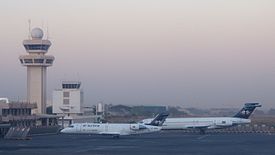Ouagadougou Airport
| Ouagadougou Airport | |||||||||||||||
|---|---|---|---|---|---|---|---|---|---|---|---|---|---|---|---|
 |
|||||||||||||||
| Summary | |||||||||||||||
| Airport type | Public / Military | ||||||||||||||
| Serves | Ouagadougou | ||||||||||||||
| Location | Ouagadougou, Burkina Faso | ||||||||||||||
| Hub for | Air Burkina | ||||||||||||||
| Elevation AMSL | 1,037 ft / 316 m | ||||||||||||||
| Coordinates | 12°21′11″N 01°30′44″W / 12.35306°N 1.51222°WCoordinates: 12°21′11″N 01°30′44″W / 12.35306°N 1.51222°W | ||||||||||||||
| Map | |||||||||||||||
| Location of the airport in Burkina Faso | |||||||||||||||
| Runways | |||||||||||||||
|
|||||||||||||||
| Statistics (2011) | |||||||||||||||
|
|||||||||||||||
| Passengers | 527,524(2,014) |
|---|
Ouagadougou Airport (IATA: OUA, ICAO: DFFD) is an airport in the center of the city of Ouagadougou in Burkina Faso. It was built in the 1960s, and it is approximately 1.5 km southeast of the main commercial area. The site itself is approximately 4.8 km in length, 0.5 km in width at its narrowest point, and covers an area of approximately 426 hectares. Its runway is 3 000 m long. When the airport was built it was on the southern boundary of the city. Ouagadougou has since experienced rapid urbanization and the airport is now surrounded by urban development.
Besides having outgrown its capacity constraints, Ouagadougou Airport is a source of pollution and risk. The government has plans for a new airport 30 km north of the capital.
In addition to civilian traffic, the airport has a military sector.
'Ouagadougou Airport handles about 98% of all scheduled commercial air traffic in Burkina Faso. Air Burkina and Air France handle about 60% of scheduled passenger traffic. Between 2005 and 2011, air passenger traffic at Ouagadougou airport grew at an average annual rate of 7.0%, reaching about 404,726 passengers in 2011 and was estimated to reach 850,000 by 2025.
In 2007 it was the 15th busiest airport in West Africa in passenger volume, just ahead of Port Harcourt (Nigeria) and behind Banjul (Gambia).
The total air cargo grew 71% from 4,350 tons in 2005 to about 7,448 tons in 2009.
The United States military uses the military side of the airport as the hub of its airborne intelligence operations for much of Western Africa.
The surveillance operations are carried out mainly with small, unarmed turboprop aircraft disguised as private planes but full of surveillance equipment. The U.S. spy planes fly hundreds of miles north to Mali, Mauritania and the Sahara, where they search for Al-Qaida fighters from the Maghreb. The planes refuel on isolated airstrips favored by African bush pilots, extending their effective flight range by thousands of miles.
...
Wikipedia

